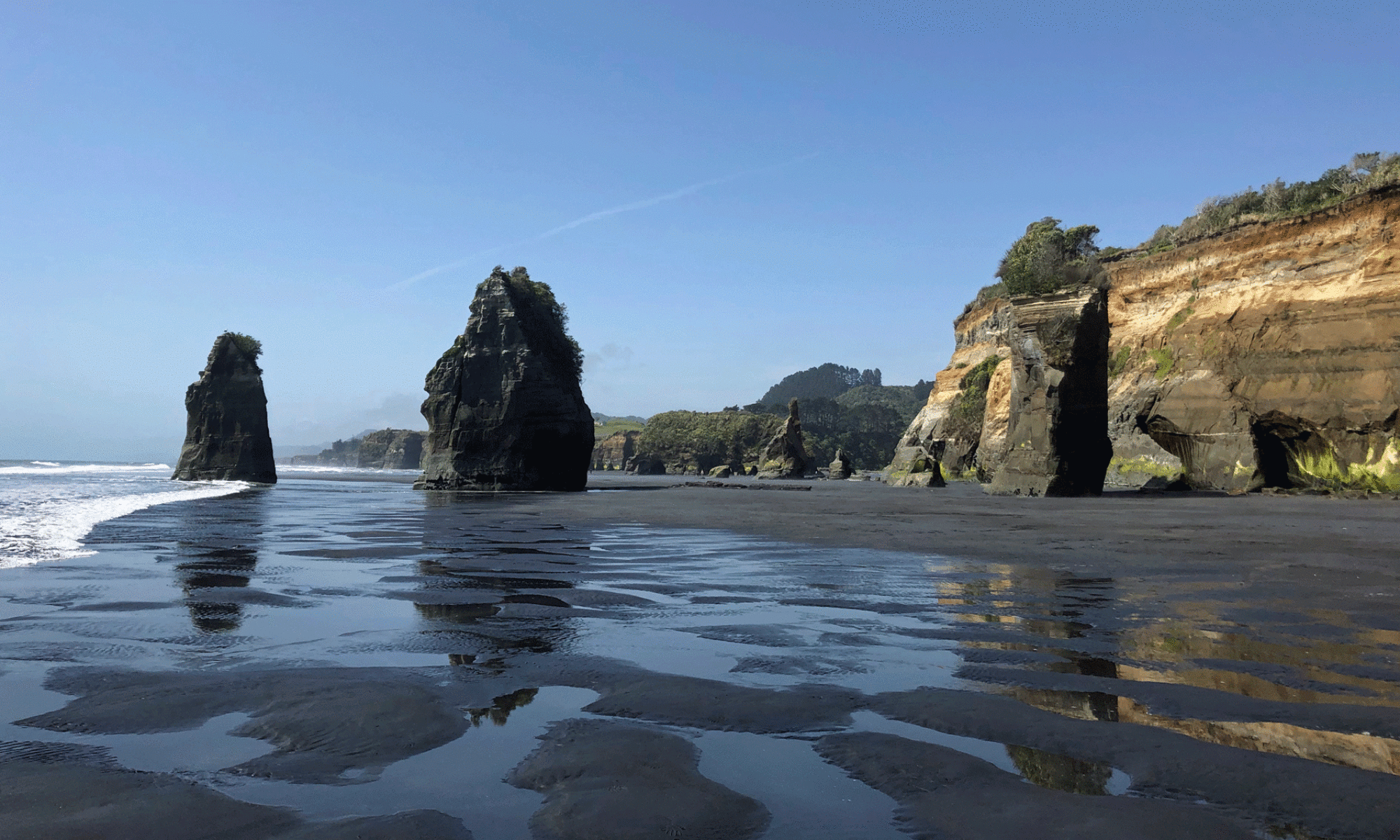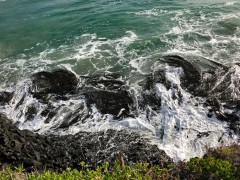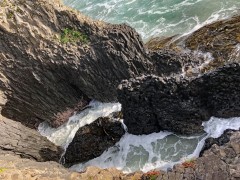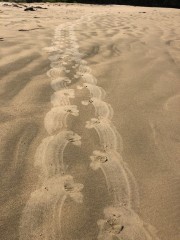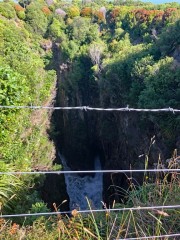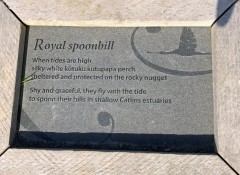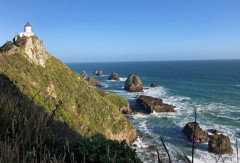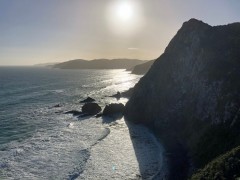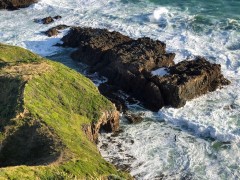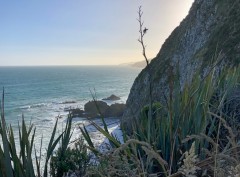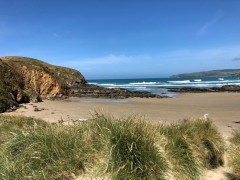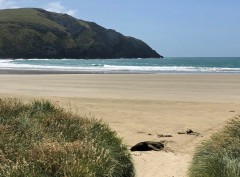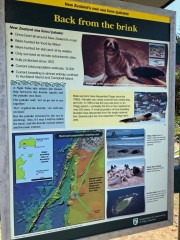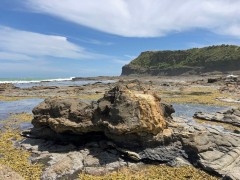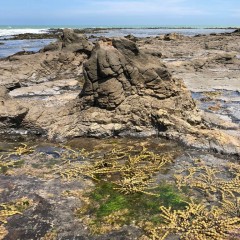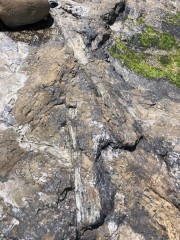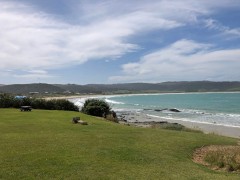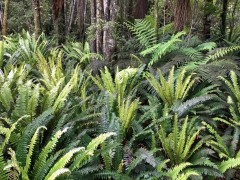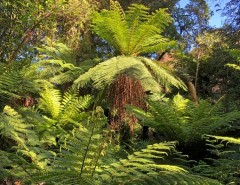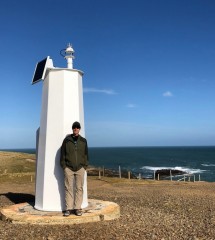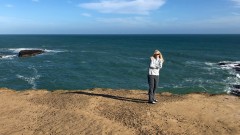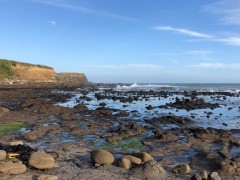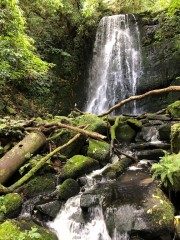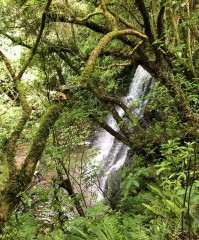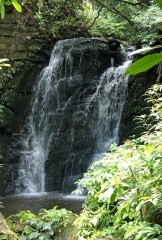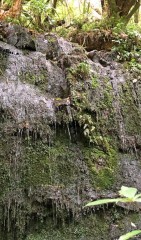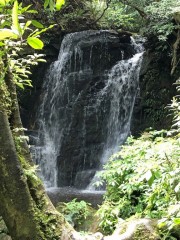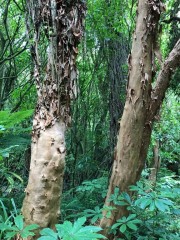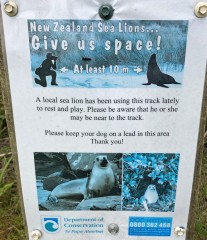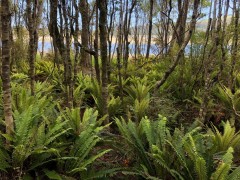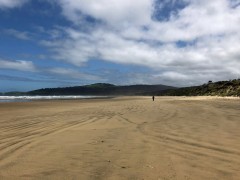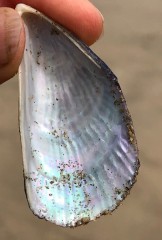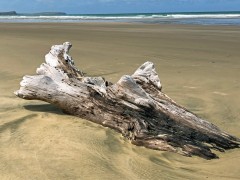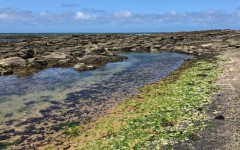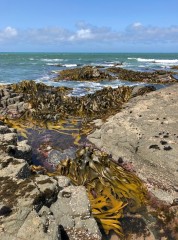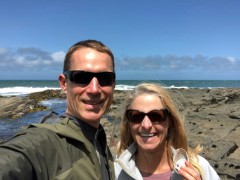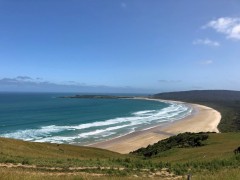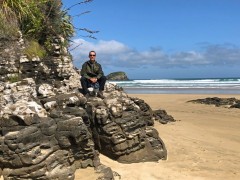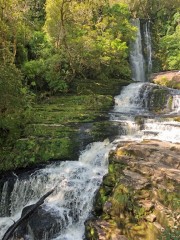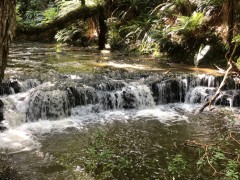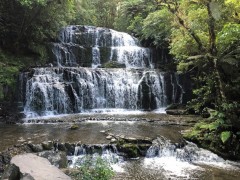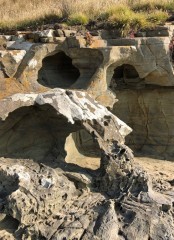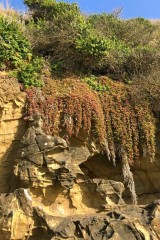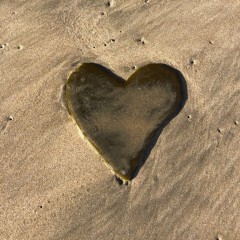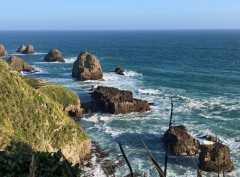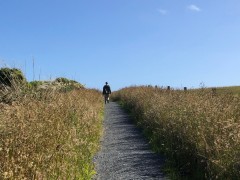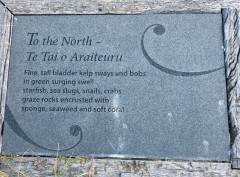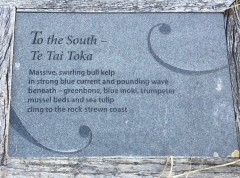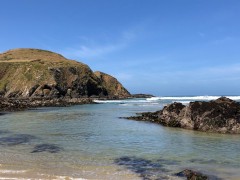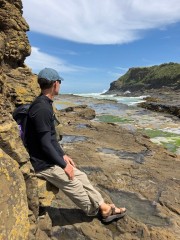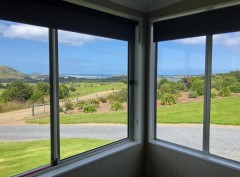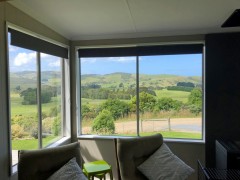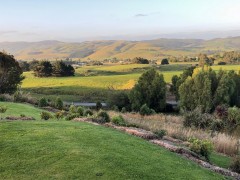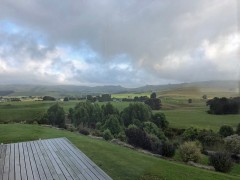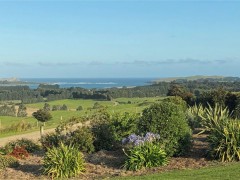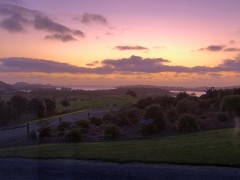A short stay in the peaceful and remote south
The Catlins is the southernmost part of New Zealand mainland and relatively unspoiled, although definitely full of pastures and also with its fair share of campervans and bachs. It consists of rolling hills, long empty beaches and beautiful coastline, with some rainforest sprinkled in for fun.

When planning our trip, I didn’t think it warranted a whole week so booked a partial. Now I think we would have found plenty to do in 7 days and also enjoyed the sheer peace of the place for much longer. We have three nights here and then a full week in Wanaka before another short stay of four nights in Fiordland so I’m splitting these posts by location rather than Mon-Mon as is typical for us.
Monday – Move Day
I can’t resist one last walk on St Clair’s beach and neighborhood on such a beautiful day before we depart.
Then we did our grocery and chemist shopping around Dunedin after our pack/clean routine and so although Owaka is only a couple hours south of Dunedin, we were able to go straight to our new home and drop off stuff before heading out to play.
Jacks Blowhole is nearby and the drive there along the estuary is pretty, but the beach when we arrived is beautiful with its granite cliffs on one side and sweeping green headland on the other. We strolled the beach, met a sea lion and then did the short but breathtaking coastal walk to the blowhole itself. Jacks doesn’t actually blow but it was interesting to see the ocean 200 meters inland through this deep hole in the ground.

Late afternoon/evening is the best time for spotting penguins so we bundled up and went to Roaring Bay where DOC has set up a hide for people to watch them come ashore without disturbing them. They swim out in the ocean all day fishing and come home to their nests at night, this time of year to regurgitate enough fish to feed their fledgling chicks.

The news about Yellow Eyed Penguins (Hoiho) is not good and their numbers are declining at a terrifying rate. These are the rarest of penguins and endemic to New Zealand. Under threat from human disturbance, habitat loss, introduced predators like dogs and possum/stoat/ferrets, the birds are classified as a nationally endangered species and sadly, rapidly on their way to extinction. They are also starving due to overfishing in their feeding area – the entire species will likely be gone within 20 years.

Numbers of nests are down dramatically – here at Roaring, the number dropped from 11 to 5 in just one year and at this point there may be even fewer. At Curio, where we will visit tomorrow, selfish humans who can’t keep their precious dogs on leashes resulted in 4 adult penguins being killed by these “nice dogs” which then also results in their chicks dying of starvation. There are only 3000 of these amazing creatures left in the world, but letting Fido run free on the beach with no concern for anyone or anything else is apparently more important than an entire species.
The more we learn, the more we realize how fortunate we were to witness one swim ashore here. Absolutely amazing how it surfs in, lands and begins to waddle around. These are the fourth largest penguins in the world and with binoculars, we were able to really see the movements and envision the thought going into its actions. (Sorry though, cell phone camera isn’t good enough to capture from such a distance.)

We also witnessed poor human behavior almost causing a chick to starve. There are signs everywhere saying that penguins won’t come ashore if they see people and that even one day without food can lead to starvation for the waiting chicks. This penguin swam to shore, waded onto the beach and stared up to the hide, where half a dozen people had gone outside to get better pictures. The penguin turned and went back into the water. I try to be a polite guest when in other countries, but I knew these weren’t Kiwis and I couldn’t hold back from going to the door and telling them that they needed to come inside. Eventually the penguin returned, then another idiot went outside so the penguin hesitated until another tourist went out to get the idiot and finally the penguin made his way into the dunes to return to his nest.

I was up for one more adventure and trotted out to Nugget Point while Hale warmed up and relaxed in the car. First a detour to an overlook where I saw a colony of Royal Spoonbills resting during high tide. (At low tide, they will go fish in the estuary nearby.) Then a short walk to the lighthouse where the twilight hour combines with the string of offshore rocks to create a truly magical vista.
Tuesday
Beautiful sunrise from this amazingly serene place. Then a morning full of the minor irritations of living in airbnbs – a microwave that doesn’t work and a kettle that is rather gross plus the lid won’t stay shut when boiling. Minor yes, but when those are the two routes to coffee…
Most beaches are tidal dependent here, so we took advantage of mid-day low tide to hit several. First up were Surat Bay and Cannibal Bay, long sandy beaches backed by dunes, framed by low red cliffs and sprinkled with haystacks just offshore. If that isn’t enough, the main “attraction” is that sea lions frequent these beaches for resting in the sand.

The sea lions we met here are different than the abundant seals we have seen further north in NZ and are a unique species also known as the Hookers Sea Lion that is endemic to New Zealand, with only about 12,000 in existence making them one of the rarest in the world. The local population on this southern part of the South Island is only now recovering after years of slaughter by humans. (The majority of them breed on New Zealand’s sub-Antarctic Auckland and Campbell islands.) They are also fierce animals who will just as likely charge you than waddle away from you if you get too close. And they are enormous – the males are up to 450kg (that’s close to 1000 lbs for those of you who speak that measurement.) For all those reasons, we always give them a wide berth of at least the 30 meters requested by DOC.
Sure enough, we were treated to a couple of sea lion shows on Surat beach and then, after walking the track over the hill to reach Cannibal Bay, we were foiled in our attempt by a sea lion napping right where the path enters the beach from the dunes. Such a privilege to be in the presence of these giants.

The Catlins is a small area, but getting anywhere takes a lot of time due to the curving roads, which also tells you that they are beautiful as we drove over hills, through valleys and over headlands with views down to sweeping ocean vistas. We resisted all the tempting stops along the way west to Curio Bay to hit it before mid-tide and were rewarded with a fascinating exploration of the tidal shelf there which contains a petrified forest.
This is one of the most extensive and least disturbed examples of a Jurassic fossil forest in the world. 170 million years ago the Curio Bay area was a broad forested coastal floodplain then the forest was flooded by volcanic debris. Over millions of years, the sediments were buried deeply and impregnated with silica minerals, eventually turning the wood to rock. Over the last 10,000 years New Zealand’s current coast line has been formed and the sea has eroded away the layers of sandstone and clays – exposing tree stumps and logs. (Idiot behavior here too – souvenir hunters have removed many of these rare fossils, so many of the tree stumps are gone, but the base of them and the fallen logs remain.)

We picnicked overlooking Porpoise Bay where we searched in vain for the local population of Hectors dolphins. It appears this and the kiwi bird will be the two that elude us during our time here.
Catlins isn’t all about the coast so next up was a waterfall hike through a dense fern forest alongside a gurgling stream. We were amazed by how happy we were to be back in the deep green and realized we have spent the last several weeks enjoying drier bush walks, coastal headland walks and cityscapes. The waterfalls themselves were breathtaking, but the whole muddy hike was a treat.

We couldn’t resist the photo-op visit to Slope Point, the southernmost tip of the South Island of New Zealand. We were lucky that the sun was shining and the roaring 40s quiet as we stood on the edge of the mainland and looked over the Foveaux straight towards Antartica.

We stopped back at Curio Bay and spent about 30 minutes watching for Yellow Eyed Penguins to come ashore, but there are only 5 left here, down from 30 just last year, and we didn’t have luck. We gave up and made the long drive home, arriving just as early dusk started to fall at 9:30.
Wednesday
The cloudy morning made for a beautiful light show on the water and the hills as the sun peaked through in pockets. Another annoyance of Airbnb life – this time fighting with a washer to try to get it to do cold wash. Two hours later, I gave in and let it do the warm cycle it wants.
Today is our day to do all the small natural attractions that we sped by yesterday in our hurry to Curio Bay. Throughout the day, we scattered in four great cascades. Matai and Horsetail Falls are reached via the same green path, yet so different in their appearance. McLean Falls and Purakanui Falls are both popular and deservedly so. All are reached by very short and easy, yet lovely, forest walks.
Sprinkled amongst those stops, we walked an old coach track to long, windswept Tohakopa Beach and a short stroll on extremely picturesque Tautuku Beach. Our favorite beach walk of the day wasn’t a beach at all, but rather the rocky shelves of Papatowai Picnic Point with its fascinating layers of sediments and fossils as backdrop to the blue ocean and long tangles of seaweed.
We ended the day with a long, lonely drive out to Long Point for a last solitary stroll on deserted Helen Beach, sharing the beauty with just one lone seal.
Wrap
We loved the peace of the Catlins, the wildlife, the wide open spaces, the empty feeling of so few people for such a big area and the sheer beauty of it all. We’d return here in a heartbeat and slow down to truly take advantage of not only the sights but also the serenity.
Week 13A of our journey
